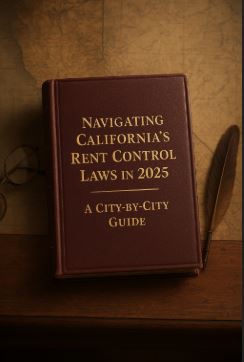Introduction: Why Rent Control Matters in California 2025.
Rent control continues to shape California’s housing market, influencing how tenants and landlords navigate leases, pricing, and property investments. In 2025, the need for stable housing and fair rent increases is more pressing than ever as urban centers face housing shortages, rising costs of living, and evolving legislation. Understanding rent control is essential not just for renters trying to protect their homes, but also for landlords aiming to remain compliant and profitable.
Statewide Overview: Key Rules All Tenants & Landlords Should Know.
California’s statewide rent control laws, largely defined by the Tenant Protection Act of 2019, continue to set the baseline:
- Annual rent increase cap : Typically 5% plus the local inflation rate, not exceeding 10%.
- Just cause for eviction : Landlords must provide valid reasons for eviction after a tenant has occupied a unit for 12 months.
- Exemptions : Newer buildings usually 15 years or younger, single family homes unless owned by corporations or REITs, and some duplexes remain exempt.
In 2025, adjustments to this law have focused on closing loopholes, clarifying exemptions, and ensuring rent caps align with economic conditions.
Los Angeles: Understanding the Rent Stabilization Ordinance.
Los Angeles has one of the most established rent control frameworks in the state. The RSO applies to most multi unit properties built before October 1, 1978, and offers:
- Annual rent increase limits, often set lower than the statewide cap.
- Restrictions on no fault evictions.
- Relocation assistance requirements for displaced tenants.
In 2025, Los Angeles also expanded enforcement, increasing penalties for non-compliance and adding tenant education programs to reduce disputes.
San Francisco: Tenant Protections and Local Rent Caps.
San Francisco has long been known for its robust tenant protections. Under its rent ordinance:
- Buildings constructed before June 13, 1979, are generally covered.
- Rent increases are closely tied to the Consumer Price Index, often resulting in much lower annual increases than the statewide law.
- Strong eviction protections and substantial relocation payouts apply.
Recent updates include stricter reporting requirements for landlords and enhanced mediation programs to resolve disputes before they escalate.
Santa Monica: Strict Measures and How They Affect Renters.
Santa Monica’s rent control system remains one of the strictest:
- Units built before April 10, 1979, are typically covered.
- Rent increases are capped annually based on CPI but have strict maximums.
- Tenants benefit from extensive protections, including limits on pass through costs for renovations or utilities.
In 2025, Santa Monica introduced additional transparency measures requiring landlords to register rent controlled units and disclose all increases publicly.
Berkeley: Navigating Rent Control Ordinances.
Berkeley’s Rent Stabilization Board continues to actively manage local rent control:
- Most multi unit buildings built before June 1980 are subject to controls.
- Annual increases are CPI based with strict enforcement.
- Tenant rights are strongly protected, and landlords must adhere to relocation payment rules for certain evictions.
Berkeley has also implemented new educational initiatives for both landlords and renters, ensuring better awareness of rights and responsibilities.
Sacramento: Tenant Protection and Relief Act Highlights.
Sacramento does not have as extensive a rent control framework as Los Angeles or San Francisco but is covered by statewide AB 1482. However:
- Local ordinances add additional oversight in some neighborhoods.
- Relocation assistance for no fault evictions has been strengthened in 2025.
- Increased enforcement measures aim to prevent illegal rent hikes in high demand areas.
Other Notable Cities: Oakland, Richmond, Beverly Hills, and More.
Several other California cities maintain strong rent control laws:
- Oakland : Covers most multi family units built before 1983, with strict annual caps.
- Richmond : Enforces a Rent Control and Just Cause Ordinance with CPI based caps.
- Beverly Hills : Expanded its rent stabilization ordinance to include more multi unit buildings.
Smaller cities like West Hollywood, East Palo Alto, and Mountain View also maintain local rules that tenants and landlords must understand before entering lease agreements.
Recent Changes: 2025 Updates to Rent Control Laws.
2025 brought a series of statewide and local updates aimed at tightening enforcement and increasing housing stability:
- Expanded coverage : Fewer exemptions for corporate owned single family homes.
- Stricter penalty frameworks : Cities like Los Angeles and Oakland now impose higher fines for illegal evictions or rent increases.
- Data driven adjustments : CPI limits and allowable increases are recalibrated to reflect post pandemic economic patterns.
Tenants now have greater access to online resources and complaint filing systems, while landlords face tighter reporting deadlines.
Tips for Tenants: Know Your Rights and Avoid Pitfalls.
Renters should stay proactive by:
- Verifying if their unit is covered under local or statewide laws.
- Keeping written documentation of rent payments and communications.
- Utilizing free or low cost tenant legal resources when disputes arise.
- Staying informed about annual rent cap adjustments to avoid overpaying.
Being aware of your rights can prevent illegal increases or unjust evictions.
Tips for Landlords: Compliance and Managing Increases.
For landlords, compliance is key:
- Stay updated on both statewide rules and local ordinances that may overlap but differ in specifics.
- Provide proper notice for increases and always stay within legal limits.
- Keep detailed records of upgrades or improvements if planning to apply for exemptions or pass throughs.
- Consider working with a property management team familiar with rent control regulations to reduce risk.
Following these steps helps avoid legal disputes and maintain good relationships with tenants.
Conclusion: Staying Informed in a Shifting Market.
California’s rent control landscape in 2025 is a patchwork of statewide rules and local regulations, each designed to protect tenants while balancing landlord rights. Whether you’re renting in Los Angeles, investing in San Francisco, or managing properties in Sacramento, staying informed is crucial.
The rules may evolve, but the trend is clear: stronger tenant protections and stricter enforcement are becoming the norm. For tenants, this means greater stability; for landlords, it requires proactive compliance and careful planning.
Understanding your city’s specific rent control measures isn’t just about following the law it’s about making smarter housing decisions in one of the most dynamic rental markets in the nation.
Expand your understanding with the sources below:
Navigating California’s Rent Control Laws: What Every Investor Should Know- https://www.bcre.co/blog-news/navigating-californias-rent-control-laws-what-every-investor-should-know/
Navigating 2025 Rental Laws in San Francisco, CA: A Comprehensive Guide- https://rayrealtor.com/blog/navigating-2025-rental-laws-in-san-francisco
California’s Rent Control Explained- https://www.tenantstogether.org/resources/list-rent-control-ordinances-city








Leave a Reply